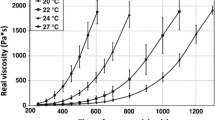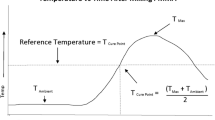Summary
For metastatic disease of the spine, anterior operations on the vertebral bodies often include methylmethacrylate cementation. The cement curing process may produce high temperatures in the surroundings, as demonstrated in joint replacement surgery, and there is a risk of thermal injury to the spinal nerves. In cadavers, we studied the heat arising during curing of cement on the dural sac, and the temperature of the cement surface was measured when the vertebral body was reconstructed using acrylic cement in the same way as in tumor surgery. The temperature increase on the surface of the dural sac during polymerization was between 4° and 12°C, depending on the amount of protection. Only a moderate temperature elevation was measured on the surface of the dural sac, provided that the posterior cortex of the vertebra was retained together with 0.5 cm of the spongious bone or a silicone membrane.
Similar content being viewed by others
References
Eriksoon AR (1984) Heat induced bone tissue injury. An in vivo investigation of heat tolerance of bone tissue and temperature rise in the drilling of cortical bone. In: Thesis, Gothenburg
Hansebout RR, Blomquist JA Jr (1980) Acrylic spinal fusion J Neurosurg 53:606–612
Holm NJ (1980) The formation of stress by acrylic bone cements during fixation of the acetabular prosthesis. Acta Orthop Scand 51:719–726
Huiskes R (1980) Some fundamental aspects of human joint replacement. Analysis of stresses and heat conduction in bone-prosthesis structures. Acta Orthop Scand (Suppl 185):1–208
Huiskes R, Schloof TJ (1981) Thermal injury of cancellous bone, following pressurized penetration of acrylic cement. In: Proceedings of 27th Annual ORS, p 134
Krause WR (1976) Mechanical effects of orthogonal bone cutting. Thesis, Clemson University
Lundskog J (1972) Heat and bone tissue. An experimental investigation of the thermal properties of bone tissue and threshold levels for thermal injury. Thesis, Gothenburg
McAffee PC, Bohlman HH, Ducker T, Eismont FJ (1986) Failure of stabilization of the spine with methylmethacrylate. J Bone Joint Surg [Am] 68:1145–1157
Mjöberg B, Pettersson H, Rosenquist R, Rydholm A (1984) Bone cement, thermal injury and the radiolucent zone. Acta Orthop Scand 55:597–600
Moritz AR, Henriques FCJ (1947) Studies of thermal injury. II. The relative importance of time and surface temperature in the causation of cutaneous burns. Am J Pathol 23:695–720
Scoville WB, Palmer AH, Samra K, Chong G (1967) The use of acrylic plastic for vetebral replacement of fixation in metastatic disease of the spine. J Neurosurg 27:274–279
Siegal T, Tiqva P, Siegal T (1985) Vertebral body resection for epidural compression by malignant tumors. J Orthop Res 67: 375–382
Stener B (1989) Complete removal of vertebrae for extirpation of tumors. Clin Orthop 245:72–82
Toksvig-Larsen S, Franzén H, Ryd L (1991) Cement interface temperature in hip arthroplasty. Acta Orthop Scand 62:102–105
Uchiyama S, Yashiro K, Takahashi H, Homma T (1989) An experimental study of spinal cord evoked potentials and histologic changes following spinal cord heating. Spine 14:1215–1219
Wilkes R, Mackinnon J, Thoma W (1994) Neurological deterioration after cement injection into a vertebral body. J Bone Joint Surg [Br] 76:155
Zygmunt S, Toksvig-Larsen S, Säveland H, Rydholm U, Ryd L (1992) Hyperthermia during occipito-cervical fusion with acrylic cement. Epidural thermometry in 23 cases. Acta Orthop Scand 63:545–548
Yokota M, Masuhara K, Iwasaki H, Kamihara K, Ishii M, Fujii S (1992) A study of thermal effect for spinal cord. Cent Jpn J Orthop Traumatol 24:1235–1237
Author information
Authors and Affiliations
Rights and permissions
About this article
Cite this article
Toksvig-Larsen, S., Johnsson, R. & Strömqvist, B. Heat generation and heat protection in methylmethacrylate cementation of vertebral bodies. Eur Spine J 4, 15–17 (1995). https://doi.org/10.1007/BF00298412
Received:
Revised:
Accepted:
Issue Date:
DOI: https://doi.org/10.1007/BF00298412




